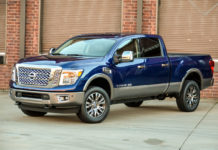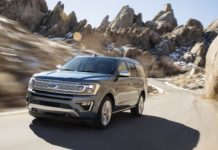As Toyota Motor Corp. prepares to deliver the first new full-size Tundra pickups to dealers, rival Nissan Motor Co. unveiled longer and brawnier versions of its Titan truck to preserve its small slice of what is becoming a fiercely competitive segment.
Toyota expects to increase big pickup sales more than 60 percent this year with the launch of the Tundra, which goes on sale next week.
Toyota predicts it will sell 200,000 new Tundras this year, and 220,000 in 2008 — the truck's first full year on the market, company officials said at a briefing on their market strategy Thursday in Detroit.
Toyota is spending more than $100 million — the most it has ever spent on a vehicle launch — to sell the new truck, a bigger and stronger version of the outgoing Tundra.
Its activities range from TV spots during the Super Bowl on Sunday to sponsorships of bass fishing contests, country music concerts and Mexican-style “charreada” rodeo events.
So far, Detroit's automakers have successfully defended their dominance in the lucrative market for full-size pickups, which account for 13 percent of U.S. vehicle sales.
Toyota started out with underpowered trucks that didn't stack up to the domestic competitors. After developing larger and sturdier trucks over the years, the Japanese automaker now holds 6 percent of the full-size pickup segment.
“We're clearly underdogs in this arena,” said Brian Smith, corporate manager for Toyota's U.S. truck operations.
Nissan, the first Japanese automaker to offer a pickup matching the capabilities of General Motors Corp., Ford Motor Co. and DaimlerChrysler AG's Dodge brand trucks, sold just more than 72,000 Titans last year — taking 3 percent of the segment. It has yet to achieve its goal to sell 100,000 trucks a year, and officials declined Thursday to make forecasts. (Honda Motor Co. doesn't make a big pickup. Its Ridgeline truck is smaller than the Tundra or Titan.)
Some auto analysts say Nissan is most likely to bear the brunt of Toyota's aggressive push into trucks, but it is responding with updated versions of the Titan, which will be shown to the public for the first time at the Chicago Auto Show next week.
“We don't want to be the piece of Toyota's pie chart a year from now that shows where all their sales growth came from,” said Larry Dominique, vice president for product planning at Nissan North America.
Nissan is expanding the Titan to include long-wheel-base versions with seven- and eight-foot-long truck beds and a specialty edition Pro-4X with enhanced off-road capabilities and a plush interior.
Dominique said he believed Toyota's truck would stimulate demand and boost sales. “We believe it's a wide open, full-size market — not import against import, or domestic against domestic.”
Competing for demographics
Full-size pickup sales fell 10 percent last year, hurt by a weak housing market and high gas prices. But Edmunds.com, an auto research site, is forecasting a rebound partly because of the new Tundra and GM's new pickups, the Chevrolet Silverado and GMC Sierra.
GM's market analyst Paul Ballew said during the U.S. automaker's monthly sales call Thursday that Toyota appeared to have priced its truck high and would probably offer big discounts.
The starting price on the Tundra is higher than GM's base prices. But Toyota officials said a comparison of a four-door Tundra with a big V8 engine and a similarly equipped Chevrolet Silverado Extended Cab showed the Toyota truck cost $2,325 less.
In addition, “we're working to offer competitive payment programs,” Smith said.
Where Nissan and Toyota may find themselves competing head-on is for Hispanic customers. Both automakers are popular with Hispanics, and Toyota is courting them with Spanish-language ads and special marketing events.
“This is a critical, critical audience for us,” said Toyota marketing manager Kim McCullough.
Toyota expects Hispanic customers to account for about 20 percent of new Tundra buyers.
It builds the truck at a plant in San Antonio, in a part of southern Texas with a large Hispanic population. It also builds the truck in Princeton, Ind., and has potential capacity to produce 300,000 a year.
Buyers 'in the driver's seat'
Alex Rosten, a pricing analyst at Edmunds.com, said that although Nissan is commonly viewed as being vulnerable, he says DaimlerChrysler AG's Dodge Ram truck looks exposed to him.
“It's the oldest one out there,” he said.
It also offers the biggest incentives — $6,496 per vehicle, compared with an industry average of $3,606 and $4,153 for the Ford F150. Ford will be refreshing its best-seller by the end of the year.
“We think it'll be a growing segment because of the Tundra and Silverado, but there'll be more pricing pressure,” Toyota marketing vice president Jim Farley said. “Buyers will be in the driver's seat.”








